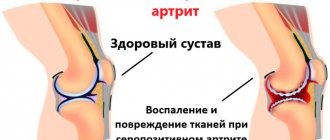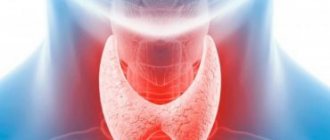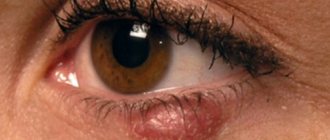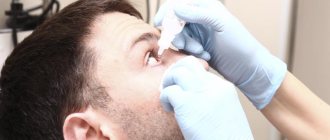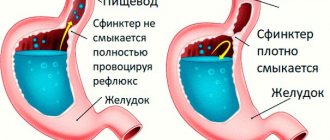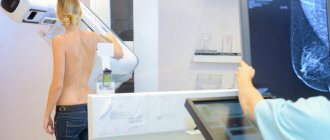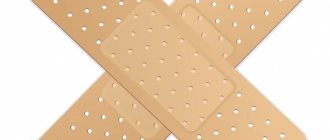Psoriatic arthritis
is a secondary inflammatory disease of the joints with a chronic course. It appears in every 4th patient with psoriasis as a consequence of the underlying disease. Often the inflammatory process affects not only the peripheral joints, but also spreads to the spine, involving ligaments and tendons.
Psoriatic arthritis is a chronic inflammation of the joints, a consequence of psoriasis.
Usually the disease makes itself felt at the age of 25-50 years, but an earlier, juvenile form
, in which the onset of the disease occurs at the age of 9-11 years. By a slight margin, women are more susceptible to psoriatic arthritis.
Although the disease is usually mild to moderate, approximately 10-15% of patients suffer from a disabling form
.
Causes of psoriatic arthritis
The exact causes of psoriatic arthritis have not yet been established by science. It is assumed that it can be triggered by the combined action of such factors as:
- hereditary predisposition to diseases of the musculoskeletal system (currently the leading cause of psoriatic arthritis, according to rheumatologists);
- severe emotional shocks, stress, work associated with high psychological stress;
- recent viral and infectious diseases;
- carriage of streptococcal infection, the presence of foci of chronic inflammation in the body;
- unfavorable environmental situation in the region of residence;
- various injuries (including those received in the distant past);
- bad habits;
- unhealthy lifestyle, especially unbalanced diet;
- overweight;
- long-term use of certain medications;
- immunodeficiency states;
- depression;
- intense physical activity;
- recent childbirth, menopause, disruption of the endocrine glands and age-related hormonal changes.
Most often, psoriatic arthritis affects middle-aged patients with autoimmune nail lesions and plaques characteristic of psoriasis. There is a relationship between the manifestation of arthritis and the state of the nervous system - loose nerves and increased excitability can trigger the onset of the disease
.
It has also been noted that women more often suffer from symmetrical psoriatic arthritis, and men are treated with inflammation of the vertebral joints and interphalangeal joints of the extremities.
Why and how the disease develops
The causes of psoriasis have not been fully established. It is believed that the immune system and hereditary predisposition play a major role in the development of psoriatic arthritis. It has been established that about 40% of patients with PsA have close relatives suffering from psoriasis.
Under the influence of any trigger factors (nervous stress, infection, hypothermia, alcohol abuse, etc.), genetically predisposed individuals experience a malfunction of the immune system. Normally, immune cells produce information molecules—cytokines—that regulate inflammatory reactions. A malfunction of the immune system leads to the fact that the normal ratio of cytokines that support and suppress inflammation is disrupted, a cytokine storm develops, and inflammation becomes uncontrollable.
Genetic predisposition manifests itself in the presence of certain antigens in the body. Thus, in the presence of the B38 antigen, psoriatic arthritis rapidly progresses with the development of a destructive process that destroys the articular surface. The presence of B17 and Cw6 antigens indicates the possible involvement of a small number of joints in the process, and the B57 antigen indicates multiple lesions.
The pathogenesis of the disease is associated with the production of antibodies to antigens. Antigen-antibody complexes are deposited in the synovium, causing an inflammatory process that is maintained for a long time by a cytokine storm. Long-term psoriatic arthritis destroys cartilage tissue, causes thinning of bone tissue (osteoporosis) and its proliferation with the development of joint deformation, immobility (ankylosis) and loss of function.
Types of psoriatic arthritis
Over ⅔ of patients with psoriatic arthritis have lesions in large joints
— in this case, the disease can spread only to one joint or affect several at once. Most often, the knee and ankle joints are affected, and a little less often the hip joints. As with rheumatoid arthritis, the disease can affect absolutely any joint. In 15% of patients, oligoarthritis occurs, in which inflammation begins in 3 or more joints.
Rheumatologists distinguish 5 conventional forms of psoriatic arthritis. It should be borne in mind that these forms can be combined, be in an intermediate state, and even transform into one another in the same patient.
- Symmetrical polyarthritis
- its manifestations resemble rheumatoid arthritis (accompanied by pain, inflammation, swelling, stiffness in the morning). This form is characterized by a relatively mild course and practically does not lead to noticeable deformations of the joints or the formation of nodules. Most often it affects the peripheral joints. - Asymmetric oligoarthritis
- affects 2-4 joints (usually the joints of the fingers and toes). It is often accompanied by dactylitis, an inflammation of the joints that leads to swelling of the fingers (the so-called “sausage fingers.” The pain with asymmetric oligoarthritis is quite intense, and the limitation of mobility is pronounced. - Arthritis involving the distal joints of the fingers
(i.e., those closest to the nail). Unlike rheumatoid arthritis, psoriatic arthritis can affect all joints of the finger, as a result of which fusion of the articular surfaces can form, leading to complete immobility of the finger. It is characterized by diffuse (edematous) swelling and redness of the skin over the joints. This form of psoriatic arthritis can affect the joints of the toes and hands, either individually or together. - Axial (axial) form
- it is characterized by inflammation of the intervertebral and sacroiliac (located in the lumbar region, in the back of the pelvis) joints. It is more often observed in men (up to 40% of those suffering from psoriatic arthritis). Accompanied by inflammatory back pain, moderate limitation of mobility when bending forward, backward and to the sides. The axial form of psoriatic arthritis is diagnosed in patients who complain of lumbar pain lasting over 3 months, which appeared before the age of 45. - Mutilating form
- this type of psoriatic arthritis occurs in approximately 5% of patients and is accompanied by disfigurement and deformation of the joints. Its characteristic feature is considered to be the so-called. telescopic fingers. This pathology is caused by the resorption of bone tissue in the terminal phalanges of the fingers and the heads of the metacarpal bones. As a result, the fingers become shortened and become swollen at the base and narrowed at the tips (cone-shaped). The fingertips become thinned and pointed. The pathology has not only aesthetic consequences: due to the curvature of the fingers, patients suffer from their subluxations and immobility of the joints, various contractures (persistent restrictions on mobility), and disruption of the normal axes of movement. Changes are almost always asymmetrical.
Rarely and exclusively in men, a malignant form of psoriatic arthritis can occur. It occurs against the background of atypical psoriasis and is accompanied by fever, chills, and severe pain that cannot be relieved with conventional analgesics. Patients rapidly lose weight, complain of the formation of ulcers, hair loss, enlarged and painful lymph nodes. Severe articular syndrome is accompanied by disturbances in the functioning of the heart, kidneys, and sometimes the brain
.
Symptoms of psoriatic arthritis
Symptoms of psoriatic arthritis are almost always preceded by dermatological manifestations of psoriasis. In this case, plaques, ulcers, and peeling of the skin can appear several years or 2-3 months before joint pain. This development of pathology is observed in at least 6 out of 7 patients; in others, the articular syndrome may be primary. Approximately 15% of patients notice symptoms of psoriatic arthritis within the first year after skin lesions.
The progression of the disease usually parallels the progression of psoriasis, but there is no direct correlation between the growth of psoriasis lesions and the complication of arthritis
.
Common nonspecific symptoms of psoriatic arthritis include:
- pain and swelling in the joints
(usually peripheral); - feeling of stiffness in the morning, which may progress
(to permanent stiffness or partial limitation of mobility) or remain in place; - enthesopathy - pain when palpating or squeezing the joints at the sites of tendon attachment
(these areas are especially susceptible to the inflammatory process in psoriatic arthritis).
Symptoms of psoriatic arthritis may be accompanied by ulcers, thimble syndrome (deformation of the nails with the formation of indentations) and other signs of psoriasis.
Specific symptoms of psoriatic arthritis (PsA) include:
- inflammation of the finger joints and their swelling in a spindle-shaped manner (dactylitis);
- swelling, which is accompanied by cyanosis and purplishness of the skin;
- stiffness of movements in the spine (in the case of psoriatic spondylitis or unilateral sacroiliitis);
- pathological change in the shape of the joints with pinkness of the skin over them;
- decreased elasticity of ligaments, tendons and muscles, which leads to discomfort during movements, dislocations and subluxations;
- increased stiffness in the second half of the night and upon waking up in the morning, as well as its gradual attenuation during everyday activities or warm-up;
- noticeable attempts by the patient to protect the affected joints and transfer the load from them to healthy ones;
- in some forms of PA - shortening of the fingers.
It is important to consider that in arthritis of psoriatic origin, rheumatoid nodules characteristic of rheumatoid arthritis are absent
.
Psoriatic arthritis often has an unpredictable course with periodic exacerbations and subsequent remission. More often it has a hidden beginning; remissions occur faster, more completely and easier than with rheumatoid arthritis. The aggressive course of the disease with rare remissions has a poor prognosis
.
If left untreated or with a malignant course, the symptoms of psoriatic arthritis can increase until the patient becomes disabled
.
Diagnosis of psoriatic arthritis
Pathogenesis
The pathology is based on a pathological process - synovitis , which manifests itself in the form of an increase in volume and accumulation of effusion (biological fluid) in the cavities of the joints. Articular syndrome is a thickening of the synovial membrane of the joints, an increase in periarticular intermuscular joints and the proliferation of intra-articular fatty tissues.
Destructive changes in joints usually occur under the influence of tumor necrosis factor , an extracellular protein called TNF-α , which activates endothelial cells and stimulates the proliferation of fibroblasts. This causes the expression of matrix metalloproteinase , stimulation of the synthesis of collagenase and prostaglandin PGE2 , activation of osteoclasts and regulation of the production of certain chemokines . An important role is also played by the formation of interaction of immunocompetent cells with keratinocytes, synovial membrane cells, cytokines , disruption of immunoregulation processes, activation of inducers of inflammation and tissue destruction.
Arthropathy and psoriatic disease in general cause alterative changes in the basic substance of the vascular walls, depolymerization of the fibrillar components of the connective tissue, while the accumulation of perivascular cellular infiltrates occurs, as well as reversible and irreversible changes in neurons.
Diagnosis of psoriatic arthritis
Diagnosis of psoriatic arthritis includes an oral interview, examination of the patient and palpation of the affected joints, as well as laboratory instrumental research methods.
- a clinical (general) blood test when diagnosing psoriatic arthritis may show an increase in ESR;
- a biochemical blood test shows increased titers of C-reactive protein (the more intense the manifestations of PA, the higher this indicator);
- In a blood test for rheumatic factor in psoriatic arthritis, rheumatic factor is usually absent. If a rheumatic factor is nevertheless detected, an anti-CCP test will help make the correct diagnosis.
Also, studies may show signs of damage to internal organs and eyes. Patients often also experience arterial hypertension.
Among hardware studies, the most informative for diagnosing psoriatic arthritis are:
- X-ray examination
(allows to detect destruction of the distal phalanges, the presence of deformities and subluxations); - magnetic resonance imaging
(MRI); - Ultrasound examination of joints
(ultrasound).
Additionally, a consultation with a dermatologist and skin scraping tests may be required. In case of damage to internal organs and eyes, other specialists are involved in the diagnostic process
.
Being secondary to an autoimmune disease, PsA shares many features with rheumatoid arthritis.
(also autoimmune etiology).
Therefore, during the diagnosis of psoriatic arthritis, it is important to differentiate these two diagnoses from each other
.
The separation of rheumatoid and psoriatic arthritis also complicates the similarity of clinical pictures: for example, ankylosing spondylitis in psoriasis and ankylosing spondylitis, Reiter's disease and psoriatic lesions of the mucous membrane of the eyes, mouth, and genital organs can only be distinguished with the help of special diagnoses
.
Self-diagnosis plays an important role in the early detection of symptoms of psoriatic arthritis. For this purpose, patients with arthritis are recommended to undergo a special screening questionnaire annually.
You should immediately consult a doctor if the patient has 4 or more signs from the list below:
- joint pain began before reaching 40 years of age;
- the pain syndrome had a hidden onset (it was not preceded by injury or another obvious cause);
- discomfort disappears after moderate physical activity;
- pain persists or even intensifies at rest;
- pain is especially annoying at night, and by the middle of the day it noticeably subsides;
- there is a rash on the body, separation and deformation of the nails.
General information
Psoriatic arthritis (PsA) or psoriatic arthropathy is a chronic systemic disease of the musculoskeletal system associated with psoriasis, that is, concomitant with it. Codes for the International Classification of Diseases, 10th revision (ICD-10) - L 40.5, M07.0 - M07.3.
According to statistics, the incidence of PsA is 3–8 per 100,000 population. Inflammatory processes in the joints with psoriasis more often appear in people against the background of existing skin rashes (70% of all patients). But it also happens the other way around, when psoriatic arthritis is the only manifestation of the disease, which significantly complicates timely diagnosis. There are about 15% of such patients; the same number of patients had both skin and joint symptoms.
Treatment of psoriatic arthritis
Treatment for psoriatic arthritis involves suppressing the body's faulty immune response.
,
relieving pain and inflammation
,
restoring synovial cartilage and other structural elements of the joint
. Taking control of psoriatic arthritis symptoms also helps prevent further joint destruction. A wide range of means are used for this: drug treatment, diet, therapeutic exercises and physiotherapy (magnetic therapy, medicinal electrophoresis, ultrasound with hydrocortisone, massage, paraffin baths, hydrogen sulfide baths, kinesiotherapy). Educating the patient on the orthopedic regimen is also advisable.
Surgical treatment of psoriatic arthritis is performed extremely rarely - when complex therapy for the disease is ineffective.
Diet for psoriatic arthritis
The diet for psoriatic arthritis involves a ratio of alkali-forming foods to acidic foods of at least 3:1.
Not recommended for patients:
- nightshades (tomatoes, potatoes, eggplants, bell peppers);
- an abundance of meat products and grains in the diet.
You should limit your consumption:
- legumes;
- oils;
- Sahara;
- starch-rich foods;
- sour berries, citrus fruits;
- adding vinegar to dishes.
It is advisable to completely exclude
from the diet:
- semi-finished products and fast food;
- sausages and confectionery products;
- snacks, chocolate;
- carbonated drinks;
- crustacean dishes and offal;
- fried food.
Apples should only be consumed baked. Lean poultry and boiled fish should be eaten 4 to 7 times a week; include eggs in your diet 2-4 times a week. Remember to eat reduced-fat dairy products. You should also drink 6 to 8 glasses of water (not drinks!) every day!
Exercise therapy for psoriatic arthritis
A set of exercises for the treatment of psoriatic arthritis is created by a physical therapy instructor. This takes into account which joints are affected, what level of athletic training the patient has, whether he has injuries and constitutional features, as well as what age he is. In addition to therapeutic exercises, walking, swimming, and water aerobics are recommended for patients with psoriatic arthritis. You should avoid traumatic sports, running
.
Therapeutic gymnastics exercises should be spent at least 30-40 minutes a day: this time should be divided into 2-3 sessions of 15-20 minutes each.
Exercises for damage to the joints of the hand
:
- clench and unclench your fingers at a fast pace;
- holding your hands at chest level, perform rotations in the wrist joints, first in one direction, then in the other;
- try to tilt your hands with straight palms as far as possible to the left and right, and then forward and backward (do not help yourself with the other hand);
- take an apple, a small ball or other round object and start squeezing it with your fingers;
- You can also perform exercises with a special wrist expander or knead plasticine.
Gymnastics for elbow joints
:
- relax your shoulders so that your arms hang freely along your body, swing them freely;
- Without changing position, try to gently rub the tissue around the elbow joint with your other hand, repeat on both sides;
- Raise your arms so that your elbows are at shoulder level. Freely swing your forearms like a ball-jointed doll;
- rotate your arms at the elbow joints, avoiding sudden, violent movements;
- take a tennis ball and roll it on the table away from you, towards you and in other directions;
- Place your elbows on the table so that your wrists are perpendicular to the tabletop. Rotate your brushes first in one direction, then in the other.
Exercises for the shoulder joints
:
- lower your arms freely, and then rotate your arms in front of you, first clockwise, then counterclockwise (alternately);
- place your elbow on a support (for example, a tabletop) and rotate your shoulder forward and backward;
- bend perpendicular to the floor, hanging your arms freely, and swing from side to side so that your arms swing like a “pendulum”;
- stand up straight and, keeping your elbows straight, “climb” your palms up the door frame.
Exercises for psoriatic arthritis of the feet
:
- pull the sock towards you, slightly swaying it from side to side (exercises can be performed standing, sitting or lying down);
- stomp on the spot or walk forward, shifting from foot to foot - first on the outer surface of the feet, then on the inner, then on the toes and on the heels;
- rotate your feet clockwise and counterclockwise.
Warm-up for knee joints
:
- stand up straight and try to spring on your feet, slightly bending and straightening your knees. At the same time, strain the leg muscles so that the load falls on them and not on the joints;
- sit on a chair and, holding your leg under your kneecap, gently pull your knee towards your chest;
- standing straight, cross your legs and begin bending, trying to reach the floor with your fingertips;
- stand up straight and place your hands on your waist, then move your legs to the side.
Gymnastics for the hip joints
:
- standing straight and holding your hands on your belt, move your straight leg to the side, slightly swinging it and trying to increase the angle of abduction;
- walk forward on a straight, unbending foot so that only the pelvic muscles work;
- sit on a chair so that the sacrum is located as close to the back as possible. After this, bend forward so that you can reach your toes with your fingertips;
- Lie on your back and, bending your knees, place your feet on the floor. Perform alternate hip abductions so that the outer side touches the floor.
Treating psoriatic arthritis at home
In mild to moderate cases of the disease, which is not accompanied by complications to the internal organs, psoriatic arthritis is treated on an outpatient basis - that is, at home with periodic visits to the doctor (usually as needed).
At home, the patient can treat psoriatic arthritis with tablets and gels, do self-massage of sore joints and do paraffin baths and therapeutic exercises.
Treatment of psoriatic arthritis
Drug treatment of psoriatic arthritis
Treatment of psoriatic arthritis with tablets is similar to therapy for rheumatoid arthritis.
- Nonsteroidal anti-inflammatory drugs
. If the course of the disease is favorable, NSAIDs can be used to control the symptoms of arthritis as an independent remedy. However, most often it is necessary to include basic drugs. - Glucocorticoids
. Steroid drugs are used in case of ineffectiveness of NSAIDs in short courses. They help quickly relieve swelling, pain and symptoms of the inflammatory process, but have side effects. For inflammation of the ligamentous apparatus, GCs are used topically. - Chondroprotectors (Artracam)
are the only group of drugs that promotes the regeneration of joint tissue. They help achieve stable remission for long months, eliminate symptoms of inflammation and significantly reduce pain. Treatment of psoriatic arthritis with tablets containing chondroitin and glucosamine sulfate helps to establish metabolism in joint tissues and improve the quality of joint lubrication - this reduces joint wear and prevents further destruction of cartilage. - Basic anti-inflammatory drugs
. DMARDs are indicated for highly active psoriatic arthritis. They help reduce the intensity of symptoms. Only a doctor should select the drug (some DMARDs are ineffective for spinal lesions). - Genetically engineered biological drugs
are the most modern, but still quite expensive, method of treating arthritis of an autoimmune nature.
Prevention of psoriatic arthritis
To prevent psoriatic arthritis, as well as to curb the activity of the disease, patients are recommended to undergo regular physical activity (PT) and maintain orthopedic correct postures while doing housework and performing work duties. Patients with psoriasis should be equipped with an ergonomic working and sleeping place to prevent injury to soft tissues or disruption of their trophism (this can cause inflammation). Also recommended:
- reduce body weight if you are overweight;
- to refuse from bad habits;
- do a 5-minute warm-up at least 3 times a day;
- protect yourself from hypothermia;
- follow a diet;
- take chondroprotectors (for example, Artracam) at least 4 months a year to preserve joints, prevent arthritis or achieve long-term remission.
Take care of your health - and don’t get sick!
Frequently asked questions about the disease
Is it possible to get disability?
If there is a dysfunction of the joint, then yes, it is possible.
Which doctor treats you?
Two doctors treat: a dermatovenerologist and a rheumatologist, but the main one is a rheumatologist.
What prognosis do doctors usually give?
It all depends on the clinical form of the disease and the rate of its progression. But in any case, the disease can be brought under control.
Psoriatic arthritis is not a death sentence; it can and should be treated at any stage of the disease. It is quite possible to relieve the patient from exacerbations, joint pain and progressive decline in function for a long time (sometimes until the end of life). Doctors at the Paramita clinic have extensive experience in treating this disease, please contact us!
Literature:
- Kungurov N.V. et al. Genetic factors in the etiology and pathogenesis of psoriasis // Bulletin of Dermatology and Venereology. 2011. No. 1. pp. 23–27.
- Yusupova L. A., Filatova M. A. Current state of the problem of psoriatic arthritis // Practical Medicine. 2013. No. 3. pp. 24–28.
- Korotaeva T.V. Standards for the treatment of psoriatic arthritis // Scientific and practical rheumatology. 2009. No. 3. P. 29–38.
- Haroon M., Gallagher P., FitzGerald O. Diagnostic delay of more than 6 months contributes to poor radiographic and functional outcome in psoriatic arthritis. Ann Rheum Dis. 2015;74(6):1045–1050. DOI: 10.1136/annrheumdis-2013-204858.
Themes
Arthritis, Joints, Pain, Treatment without surgery Date of publication: 04.11.2020 Date of update: 14.12.2020
Reader rating
Rating: 5 / 5 (1)

